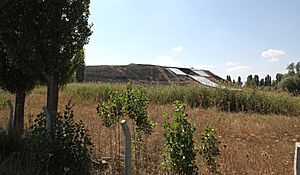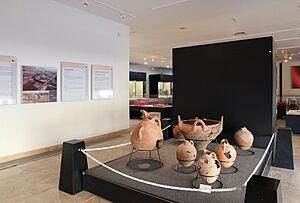Kaman-Kalehöyük facts for kids
 |
|
| Location | Turkey |
|---|---|
| Region | Kırşehir Province |
| Coordinates | 39°21′46″N 33°47′12″E / 39.36278°N 33.78667°E |
Kaman-Kalehöyük is an important ancient site in Kırşehir Province, Turkey. It's about 100 kilometers (62 miles) southeast of Ankara. The site is a "tell," which is a mound made up of many layers of old settlements built one on top of another over thousands of years.
People lived here during the Bronze Age, Iron Age, and even during the Ottoman Empire. Since 1986, archaeologists from Japan have been carefully digging here. They are from the Middle Eastern Culture Center in Japan and the Japanese Anatolian Archeology Institute. This site is about 100 kilometers (62 miles) from Hattusa, which was the capital city of the ancient Hittite Empire.
Around 550 BC, the area where Kaman-Kalehöyük is located became part of the Persian Empire. Even though not many large buildings from this time have been found, some Persian seals were discovered at Kaman-Kalehöyük. Ancient records suggest there was a settlement called Zama here long ago.
Later, around 18 AD, the Roman Emperor Tiberius made Cappadocia (the region Kırşehir is in) a Roman province. During the Roman period, both Christianity and older religions spread quickly in the Kırşehir area. In the Kaman region, there are also remains of Byzantine buildings and an old castle called Ömerhacılı. This shows that the Byzantines also lived in this area.
Contents
The "Dark Age" Discovery
Archaeologists used to think that after the powerful Hittite Empire fell around the 12th century BC, there was a "Dark Age" in Anatolia. This was believed to be a time when not much happened culturally, lasting until the 8th century BC.
However, the excavations at Kaman-Kalehöyük have changed this idea! Digs in a layer called Stratum IId, which is from the early part of this "Dark Age" (the Early Iron Age), show that life and culture continued to develop at this site. This means the "Dark Age" might not have been so dark after all.
Layers of History
Archaeologists dig through different layers, called "strata," to learn about the past. Each layer tells a story about a different time period. Here's a simplified look at the main layers found at Kaman-Kalehöyük:
- Layer I: Middle Ages
* This layer includes finds from the Ottoman Empire and the Byzantine period. * Archaeologists found things like hairpins, a ceramic bowl, earrings, rings, a stone lamp, and old coins.
- Layer II: Iron Age Settlements
* In this layer, they found brooches (called fibulae) and arrowheads. Some of these were in the style of the Scythians, an ancient nomadic group. * They also discovered decorative plates made from animal bones and painted pottery. * Several ancient stamp seals were found, including ones from the Phrygians, Achaemenid Persians, and possibly even one from the Elamite civilization. * This layer shows different parts of the Iron Age, from the time of Alexander the Great to the Middle and Early Iron Ages.
- Layer III: Hittite Period
* This layer goes back to the time of the powerful Hittite Empire (around 15th to 12th century BC). * It also includes older parts of the Hittite Kingdom (17th to 15th century BC) and even earlier Assyrian colonies (20th to 17th century BC).
- Layer IV: Pre-Hittite Period
* This is the oldest layer, going back to the Early Bronze Age. It shows what life was like before the Hittites became powerful in the region.
Amazing Discoveries: Oldest Steel and Glass
Kaman-Kalehöyük is famous for some truly amazing finds:
- The World's Oldest Steel: In 1994, archaeologists found tiny pieces of iron at the site. When scientists studied them in 2005, they discovered that some of these fragments were made of carbon steel. These pieces date back to around 1800 BCE, making them the earliest known evidence of steel being made anywhere in the world!
- Ancient Glass: Recently, some of the oldest glass ever found was also discovered at Kaman-Kalehöyük. This glass is estimated to be about 3,600 years old, from around 1600 BC. Imagine, people were making glass here so long ago!
Kaman Kalehöyük Archaeological Museum
Right next to the ancient site is the Kaman Kalehöyük Archaeological Museum. The Japanese Government helped build this museum to protect and show off the cultural treasures found at the site.
The museum is quite large, with exhibition halls, a movie corner, a library, and special rooms for research and restoration work. What's really cool is how the museum's outdoor area is designed. It looks like an excavated mound, so visitors can see how archaeologists dig and find things, as well as view the actual artifacts.
The museum also has the largest Japanese-style botanical garden outside of Japan! In 2011, the museum won the "Best green museum" award and was even nominated for the Museum of the Year in Europe in 2012.
Buklukale: Another Important Site
About 50 kilometers (31 miles) west of Kaman-Kalehöyük is another important archaeological site called Büklükale. It's located near the Kızılırmak River, which was a very important crossing point for travelers and traders throughout history. There are even remains of a Roman bridge and a Seljuk bridge (from the 13th century AD) nearby.
Büklükale was first settled in the Middle Bronze Age and later became part of the Hittite Empire. It had a walled lower town and a strong upper city with a 7-meter (23-foot) high stone wall. The buildings in the upper city were built around 1980 BC, destroyed, rebuilt, and then destroyed again around 1680 BC.
The same Japanese archaeological team that works at Kaman-Kalehöyük also started digging at Büklükale in 2009. They found a piece of a Hittite cuneiform tablet there in 2010. This was the most westerly cuneiform tablet ever found in Turkey! More recently, another tablet was found written in the Hurrian language, describing a purification ritual.
See also




